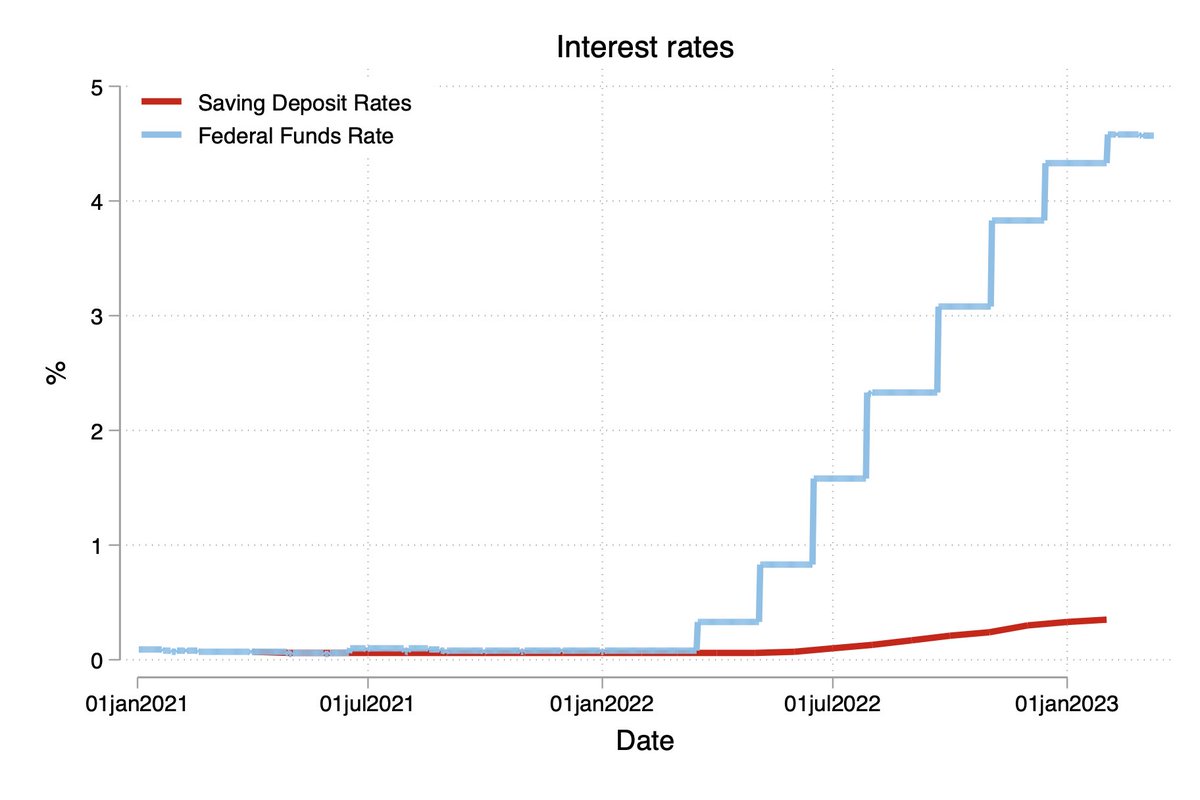*** The original sin of QE (and QT)
QE policies, adopted by the most central banks in the last 15 years, suffered from a sin at birth. This came back to bite this Thursday in the UK.
Confusingly, there are three distinct policies that go under the name of QE.
🧵 [1/15]
QE policies, adopted by the most central banks in the last 15 years, suffered from a sin at birth. This came back to bite this Thursday in the UK.
Confusingly, there are three distinct policies that go under the name of QE.
🧵 [1/15]
QE type 1 is increasing the deposits of banks at the CB. It happens when the CB borrows from banks, by issuing reserves, which are the most liquid asset in the economy. The goal is to increase liquidity in the private sector. It is about the size of the liabilities of the CB.
Most large CBs in the last decade have adopted a “saturated market“ regime (or “ample reserves” or “satiated liquidity” or “floor system”) by having large balance sheets. QE-type1 today would be a response to increases in demand for liquidity. Fed did QE1 in September of 2019.
QE type 2 is about the composition of the assets of the CB. At its simplest, the CB sells short-term government bonds and buys long-term bonds. But if there are very ample reserves and QE-type1 is neutral, then CB can do it issuing reserves and increasing size of balance sheet.
The goal of QE2 is to lower long-term yields. Usually so as to stimulate inflation and/or economic activity by lowering credit costs and complemeting forward guidance. It was used a lot in the last decade when could not lower short-term rates, "going long" for more stimulus.
QE type 3 is about buying assets in distress or giving emergency lending to financial institutions. It is about financial stability. It is the classic Bagehot role of a CB, to be a lender of last resort that halts fire sales and runs (while trying to minimize moral hazard).
As such, QE type 3 can be large but should always be short-lived. Once the run is stopped, the CB and other regulators try to fix whatever incentive or information problem there is, sell the assets they bought or collect the loans, and try to get the marks to work as normal.
Over the short history of QE, central banks committed a sin: they mixed the three types. In 2007, it was QE-type3 at first, but in 2008, it was useful to do QE-type1, and from 2010, move on to QE-type2. The difference was noted but not sufficiently emphasized in communication.
2020 made it worse. When the BoE intervened in gilt markets (or the Fed in Treasuries) this was QE-type3. But since a few days/weeks later, the CB decided it wanted to do QE-type 2 stimulus, it folded one into the other, without drawing the distinction.
When all three types of QE are pointing (at least weakly) in the same direction, there is no big problem in calling everything QE, instead of using different names for different policies. But, last week they pointed in different directions. And that led to confusion.
Thursday came, and the @BoE_Research correctly needed to do QE-type3. There was a fire sale in the illiquid 30y gilt market. But at the same time it was supposed to be doing QT-type 2 as part of monetary policy. It felt it had to cancel that. The QE original sin came to bite.
The @BoE_Research was clear in communicating that this was QE-type3: it will stop in 2 weeks, and QT-type2 will resume in one month. But many were rightly confused or doubtful. So they took this as QE-type2 and, worse, a hint of fiscal dominance.
bankofengland.co.uk/news/2022/sept…
bankofengland.co.uk/news/2022/sept…
The ECB was clearer two months ago. It will be doing QT-type2 as monetary policy over the coming months, even as it announced the TPI purchase program as potential QE-type3.
The Fed may well face the same dilemma as the Bank soon.
ecb.europa.eu/press/pr/date/…
The Fed may well face the same dilemma as the Bank soon.
ecb.europa.eu/press/pr/date/…
If for the start we had called:
“Funding/Liquidity policy” to QE-type1
“Long monetary policy” to QE-type2
“Lender and Buyer of Last Resort” to QE-type3
Or other distinct names, we would not be in this problem right now. Each has different academic literatures and tradeoffs
“Funding/Liquidity policy” to QE-type1
“Long monetary policy” to QE-type2
“Lender and Buyer of Last Resort” to QE-type3
Or other distinct names, we would not be in this problem right now. Each has different academic literatures and tradeoffs
These were my remarks at the @NIESRorg and @CFMUK conference yesterday.
Thank you @jagjit_chadha for having me.
Thank you @jagjit_chadha for having me.
https://twitter.com/jagjit_chadha/status/1575872578237128705
PS: for those wanting more on the distinction, I wrote about QE-type1 at Jackson Hole in 2016 (ideas.repec.org/p/cpr/ceprdp/1…), about QE-type2 in Santiago Chile in 2018 (ideas.repec.org/h/chb/bcchsb/v…), and about QE-type3 through CB swap lines in 2018 (ideas.repec.org/p/cpr/ceprdp/1…).
[...]
[...]
In 2020, I collaborated on projects evaluating QE at the @BoE_Research (bankofengland.co.uk/news/2022/sept…) and at the @ecb (cepr.org/publications/b…). In both I argued that making this distinction on QE policies was crucial before confusion and problems arose. They did this week.
• • •
Missing some Tweet in this thread? You can try to
force a refresh






